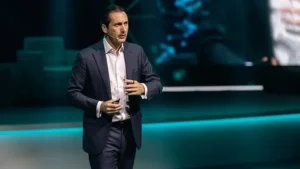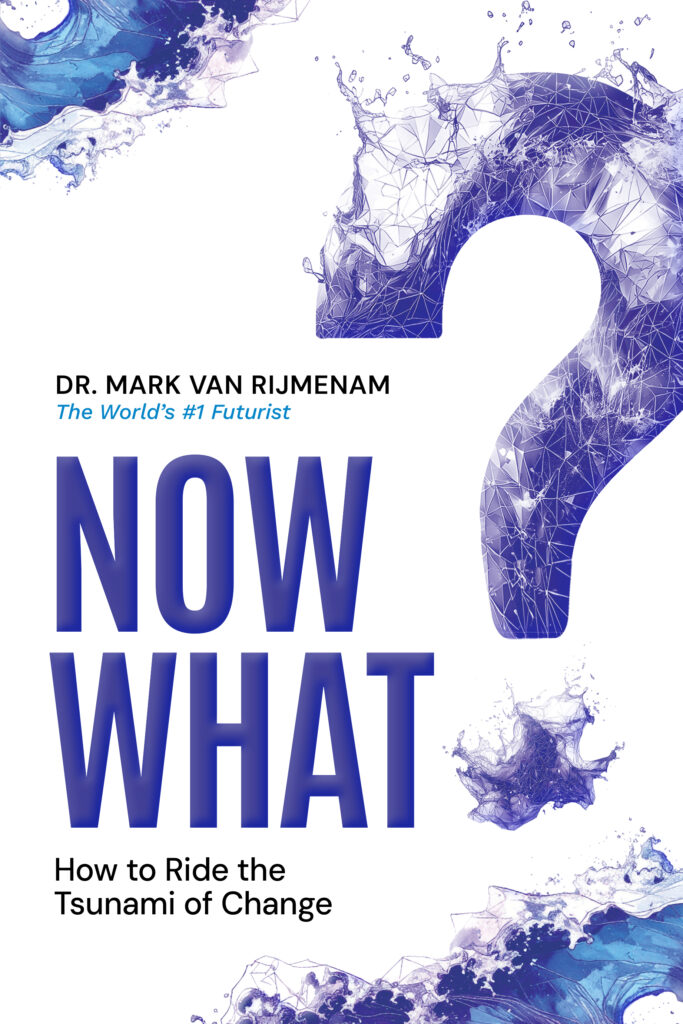Rating: ⭐⭐⭐⭐☆ (3.8/5)
Introduction: Facing the Tsunami
The future no longer creeps forward at a steady pace—it crashes like waves in a storm. Every day, breakthroughs in artificial intelligence, quantum computing, biotechnology, and robotics are reshaping how we live, work, and govern. For leaders in business and government, the challenge is not only to keep up with these changes but to ride them responsibly.
That’s the central theme of Now What? How to Ride the Tsunami of Change by Dr. Mark van Rijmenam, widely recognized as The Digital Speaker. Known as the “Architect of Tomorrow,” Dr. Rijmenam has spent years guiding executives and policymakers through technological disruption. In this 2025 release, he offers his most ambitious roadmap yet—a blend of futurist forecasting, philosophical reflection, and practical frameworks designed for those determined to thrive in an age of exponential change.
A Futurist’s Roadmap: The WAVE Framework
At the heart of the book lies the WAVE framework:
- Watch emerging technologies with curiosity and vigilance.
- Adapt strategies and structures before disruption strikes.
- Verify information and outcomes with a critical, ethical lens.
- Empower individuals and communities to shape technology’s trajectory.
Dr. Rijmenam insists that leaders who adopt WAVE will not just survive, but thrive. “The future isn’t coming,” he writes, “it’s already here—and it feels like a tsunami. The real question is not if we can adapt, but whether we will shape this tsunami to benefit humanity or allow it to wash us away.”
This framework anchors the book, offering readers a structured way to engage with a dizzying range of technologies and scenarios.
A Rich Blend of Science, Philosophy, and Storytelling
What makes Now What? unique is its multi-layered narrative style. Rather than presenting a sterile manual, Dr. Rijmenam weaves together:
- Scientific insights: Clear explanations of exponential technologies like spatial intelligence, quantum computing, and AI.
- Philosophical depth: References to Taoism, Indigenous wisdom, and systems thinking, which remind readers that progress must be guided by values, not just speed.
- Imaginative storytelling: Fictionalized glimpses of the year 2050, including courtroom debates over AI rights and stories of decentralized education systems.
For example, one of the book’s standout stories involves SIREN, an artificial intelligence on trial for personhood. This scenario doesn’t just entertain—it forces readers to confront urgent ethical questions about rights, responsibility, and the very definition of humanity.
Equally compelling is his personal anecdote of cycling across Australia. The physical endurance and adaptability required for that journey become a metaphor for how leaders must approach technological disruption: with stamina, resilience, and a willingness to adapt to shifting terrain.
Big Ideas for a Changing World
Throughout the book, Dr. Rijmenam insists that technological progress must be coupled with human progress. Some key themes include:
- Rethinking Education: Preparing future generations for jobs that don’t exist yet by emphasizing creativity, adaptability, and ethical reasoning.
- Ethics in Innovation: Asking not just can we build it? but should we build it?
- Global Cooperation: Recognizing that challenges like climate change and AI governance can only be addressed collectively.
- Resilience as a Core Skill: “Change is the only constant in life,” he reminds readers. “Trying to stop it is like attempting to freeze the tide.”
These sections resonate deeply with leaders who are tired of one-dimensional “tech optimism” and crave a more holistic, human-centered vision.
Strengths of the Book
The greatest strength of Now What? is its breadth and balance. It doesn’t just celebrate technology—it interrogates it. The author’s ability to move fluidly between hard science and philosophical reflection is rare, and it gives the book a richness many futurist texts lack.
- Practical and visionary: The WAVE framework and accompanying action points give readers concrete tools.
- Engaging storytelling: Vivid narratives like SIREN’s trial or the author’s personal adventures bring abstract ideas to life.
- Urgent and hopeful: While the book highlights the risks of unregulated technology, it consistently frames the future as something we can actively shape.
For executives and policymakers, this balance of inspiration and practicality makes the book a valuable guide.
The Drawback: A Dense and Lengthy Journey
That said, Now What? is not a quick read. At over 300 pages, it covers a vast landscape—technology, ethics, philosophy, governance, and more. While this thoroughness is impressive, it may overwhelm readers who want quick, digestible takeaways.
If you’re hoping to “change the world in 200 pages,” this isn’t that book. As I noted in my highlights, it requires patience and focus. For readers willing to engage deeply, the reward is clarity and wisdom. But for those seeking brevity, the density may feel like a barrier.
About the Author: Dr. Mark van Rijmenam
Dr. Mark van Rijmenam is a leading voice on digital transformation and disruptive innovation. Known as The Digital Speaker, he has advised Fortune 500 companies, governments, and global institutions on navigating the future.
- Expertise: Exponential technologies, AI ethics, blockchain, quantum computing, and digital leadership.
- Career: Founder of Datafloq and Mavin, keynote speaker, author of several influential books.
- Style: Engaging, challenging, and deeply interdisciplinary.
Mark’s ability to combine rigorous research with engaging storytelling has earned him recognition as one of the most influential futurists of our time.
📌 Connect with the Author
- Website: TheDigitalSpeaker.com
- Amazon: Now What? How to Ride the Tsunami of Change
- Press Kit & Bio: Press Kit
Overall Rating & Recommendation ⭐⭐⭐⭐☆ (3.8/5)
Now What? is a bold, ambitious, and multi-dimensional book. It challenges readers to stop being passive observers of change and instead become active shapers of the future.
- For business leaders, it’s a strategic framework for navigating disruption.
- For government leaders, it’s a call to regulate wisely while encouraging innovation.
- For curious readers, it’s a chance to see how today’s trends might evolve into tomorrow’s realities.
The only drawback? Its length and density. But perhaps that’s fitting—for a world this complex, a detailed outlook is necessary.
👉 Order your copy today and prepare to face the tsunami of change with courage, clarity, and conviction.
Conclusion
“Ultimately, Now What? is not just about riding the waves of change—it’s about becoming the architect of tomorrow. It is a demanding read, but for those willing to invest the time, it offers clarity, wisdom, and a roadmap for shaping a future where exponential progress serves humanity.”







